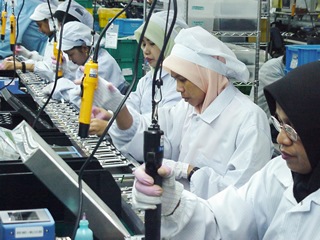Interview with Mr Frank Simonis of Philips
3. Interview with Frank Simonis of Philips
Review Pages
2. Interview with Frank Simonis of Philips
3. Interview with Frank Simonis of Philips
 What are the differences that you have seen between the three key markets, North America, Asia and Europe, especially in terms of how they develop and adopt new technologies?
Where Japan is in most cases a launch territory for new technology, by now the growth rate is slowing down compared to the other regions. Both the European and US markets are expanding heavily. The US is known to be the largest market right now for PC writers, while Europe is the largest market for DVD Recorders.
What are the differences that you have seen between the three key markets, North America, Asia and Europe, especially in terms of how they develop and adopt new technologies?
Where Japan is in most cases a launch territory for new technology, by now the growth rate is slowing down compared to the other regions. Both the European and US markets are expanding heavily. The US is known to be the largest market right now for PC writers, while Europe is the largest market for DVD Recorders.
What role if any, will China play in Philips's development, both for manufacturing and as a market? Philips has been firmly established in China since 1985 (for more then 3 decades) and has expanded to become one of the largest industrial investors in the country. Total revenue in China reached over US$7.5 billion in 2003, with a cumulative investment exceeding US$2.6 billion. Philips presence in China goes beyond manufacturing. In 2000, Philips established its Philips Research East Asia in Shanghai to conduct strategic research and development. This center is on top of the 12 other world-class R&D facilities already functioning in China for new developments in lighting, color TV, audio, semiconductor, and medical systems. Philips remains committed to a solid presence in China by forming proactive partnerships with local companies, government bodies and research institutions. We hope this productive framework will help in setting standards in the industry and enhancing the competitiveness of the Chinese economy.
How big a role does R&D play? Philips has a long track record in optical storage technologies and standardization, from laser disc in 1978, audio CD in 1982, CD-Rom in 1984, CD-R in 1989 to DVD video/rom in 1995 and DVD+RW in 1997. Philips is now one of the companies developing the next generation optical format Blu-ray Disc.
Philips has always put emphasis on R&D and has become one of the world's major private research organizations. The total R&D efforts for Philips Electronics amounts to approximately 8% of sales. Our R&D activities have led to the award of some 100,000 patents.
 Do you design all your circuit boards and write all firmware for your optical drives in-house?
As indicated earlier, Philips focuses its development and manufacturing on "key" components, IC chipsets and the development of reference designs in-house. Consumer DVD recorders are developed and manufactured in-house. In order to meet the dynamic market demands and fast product lifecycles (currently less than 6 months), Philips partners with BenQ in the joint venture PBDS.
Do you design all your circuit boards and write all firmware for your optical drives in-house?
As indicated earlier, Philips focuses its development and manufacturing on "key" components, IC chipsets and the development of reference designs in-house. Consumer DVD recorders are developed and manufactured in-house. In order to meet the dynamic market demands and fast product lifecycles (currently less than 6 months), Philips partners with BenQ in the joint venture PBDS.
An added cost to manufacturing costs is the royalties that must be paid. What are your views on this and what would you like to see change here? In our day-to-day life, products depend more and more on innovative technologies. Innovative companies like Philips, provide the world with new technologies on a continual basis. We share our innovations by licensing them to third parties against fair and reasonable conditions. By licensing our technologies to other companies, they get a ticket to new markets. And consumers can get access to innovations even quicker and against better prices, as we have seen in the past with CD and we currently see in the DVD market. Philips re-invests its licensing income in R&D in order to be able to continue delivering meaningful innovations to the world. We think licensing has advantages for all parties and the cost for licensing should be seen as part of the cost price: the cost for innovation.
Review Pages
2. Interview with Frank Simonis of Philips
3. Interview with Frank Simonis of Philips













